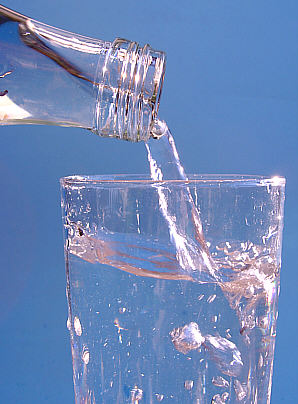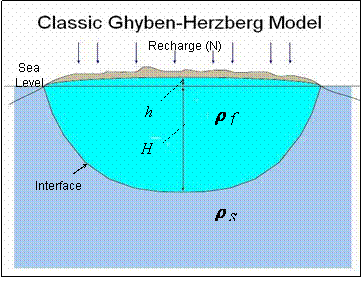Difference between revisions of "Fresh water"
Thebastidge (talk | contribs) |
Thebastidge (talk | contribs) (→Fresh water lens) |
||
| Line 55: | Line 55: | ||
[[Image:Ghyben-Herzberg.gif|frame|Ghyben-Herzberg lens]] | [[Image:Ghyben-Herzberg.gif|frame|Ghyben-Herzberg lens]] | ||
| − | + | Freshwater Lens' are a natural rainwater catchment. Human can survive about anywhere provided there is enough fresh water. Moreover, fresh water is lighter than sea water. So the best place to live is on top of a mass of porous materiel saturated of fresh water (like a kitchen sponge). In natural islands this is known as the [http://www.emwis-mt.org/documentation/Context/Physical%20factors_files/Ghyben-Herzberg.htm Ghyben-Herzberg lens]. | |
| − | Human can survive about anywhere provided there is enough fresh water. Moreover, fresh water is lighter than sea water. | ||
| − | |||
| − | So the best place to live is on top of a mass of porous materiel saturated of fresh water (like a kitchen sponge). In natural islands this is known as the [http://www.emwis-mt.org/documentation/Context/Physical%20factors_files/Ghyben-Herzberg.htm Ghyben-Herzberg lens]. | ||
[https://wattsupwiththat.com/2010/01/27/floating-islands/ The water in a lens is only supplied naturally from rain]. If the island is large and deep enough (40 times deeper that its height), it will be naturally protected against salt water intrusion. Otherwise, some watertight barrier (or a porous material that resists mixing of the liquid absorbed in it, like a coral ring) is needed. [http://www.americanthinker.com/articles/2009/04/sinking_islands_or_stinking_is.html Withdraw too much water and allow it to run into the sea], and you will see the lens become shallower, perhaps enough that wells will have saltwater in their lower depths. Destroy your encircling coral ring, and the whole thing [http://www.telegraph.co.uk/news/worldnews/australiaandthepacific/tuvalu/7799503/Pacific-islands-growing-not-shrinking-due-to-climate-change.html could be eroded away]. | [https://wattsupwiththat.com/2010/01/27/floating-islands/ The water in a lens is only supplied naturally from rain]. If the island is large and deep enough (40 times deeper that its height), it will be naturally protected against salt water intrusion. Otherwise, some watertight barrier (or a porous material that resists mixing of the liquid absorbed in it, like a coral ring) is needed. [http://www.americanthinker.com/articles/2009/04/sinking_islands_or_stinking_is.html Withdraw too much water and allow it to run into the sea], and you will see the lens become shallower, perhaps enough that wells will have saltwater in their lower depths. Destroy your encircling coral ring, and the whole thing [http://www.telegraph.co.uk/news/worldnews/australiaandthepacific/tuvalu/7799503/Pacific-islands-growing-not-shrinking-due-to-climate-change.html could be eroded away]. | ||
Revision as of 17:25, 6 July 2017
- Water, water, everywhere,
- And all the boards did shrink;
- Water, water, everywhere,
- Nor any drop to drink.
Contents
Desalinization
There is an interesting article about a thermal vacuum desalination method that would be an excellent fit for a seastead. (In contrast,) Vapor compression is a relatively energy-efficient steam distillation method that's mature, available and already widely used.
"Thermo-Ionic"
Saltworks Technologies. Supposedly uses a lot less energy than other methods.
Reverse Osmosis
In the boating world, reverse osmosis (RO) machines are also called "watermakers".
One manufacturer is link Katadyn.
Katadyn PowerSurviver 40E 1.5 gal/hr 12V@4A=48W 3yr warranty $2999
Katadyn PowerSurviver 80E 3.0 gal/hr 12V@8A=96W 3yr warranty $3899
Katadyn PowerSurviver 160E 7.0 gal/hr 12V@18A=216W 3yr warranty $4299
Osmosis is the process of liquid mixtures of different densities equalizing their density by diffusion and mixing. Reverse osmosis is the exact opposite- one liquid becomes less dense (in the relevant example for seasteading, seawater loses salt to become freshwater while adding extra salt to the seawater "brine" effluent that is higher concentration than normal). It takes additional energy to make one liquid less dense at the expense of another liquid becoming more dense, rather then the density of the two equalizing.
Things that are important to know when designing a RO solution:
-pore size of the filtration media used to remove salt from seawater -pore count per area (e.g. pores/sq cm) -he pressure used to force the water through it.
These factors will determine the speed (unit volume per time unit, generally gallons or liters per hour) capacity of the RO system.
Rainwater Harvesting
Rain is responsible for depositing most of the fresh water on the planet, most of it over the ocean (see wikipedia).
If you ever lived in a tropical country, you quickly learn to expect a daily rain fall between 5 and 6 o'clock of about half an hour. And collecting rain fall is easy with a little planning and minimal materials. Rainwater can be collected in tarps, plastic sheeting, or any impermeable roof and some gutters into a cistern.
Post on collecting rain.
Dehumidification
In humid/subtropical to tropical environments, dehumidification is a vital part of maintaining a healthy living environment free of molds and mildew that can cause severe respiratory distress and skin diseases. It also preserves the materials your structure is built of. Such system are usually integral to HVAC (Heating, Venting, and Air Conditioning) systems as changing temperatures also changes the ability of the air to carry moisture, often resulting in condensation. This condensate can easily amount to several liters or even gallons per day. This requires a drain system designed to direct it away from damaging the structure, so it makes sense to capture it as fresh water.
Straight condensate from HVAC is not yet potable water as it may come into contact with metals, lubricants, and materials which are not healthy for ingestion, in addition to trapping pollen, spores, and atmospheric contaminants along the way. But these impurities can be dealt with using a standard household water filter and do not require high energy reverse osmosis or distillation to be removed.
Fresh water lens
Freshwater Lens' are a natural rainwater catchment. Human can survive about anywhere provided there is enough fresh water. Moreover, fresh water is lighter than sea water. So the best place to live is on top of a mass of porous materiel saturated of fresh water (like a kitchen sponge). In natural islands this is known as the Ghyben-Herzberg lens.
The water in a lens is only supplied naturally from rain. If the island is large and deep enough (40 times deeper that its height), it will be naturally protected against salt water intrusion. Otherwise, some watertight barrier (or a porous material that resists mixing of the liquid absorbed in it, like a coral ring) is needed. Withdraw too much water and allow it to run into the sea, and you will see the lens become shallower, perhaps enough that wells will have saltwater in their lower depths. Destroy your encircling coral ring, and the whole thing could be eroded away.
Links
- Wikipedia article on desalination
- Wikipedia article on Reverse Osmosis
- Wikipedia article on Watermakers
- Wikipedia article on solar desalination
- Wikipedia article on Solar Still
- Wikipedia article on Rainwater Harvesting
- The Hurricane Tower "Fresh Water generation through simulation of natures hurricanes".
- Sea Solar Power
- Seawater Greenhouse
- Ghyben-Herzberg lens good explanation
| Support Infrastructure |
|---|
| Fresh water · Food · Farming · Waste Disposal · Shelter · Appliances · Communications · Transportation · Medical and Health Care · Infrastructure Example |
| Socio-Economic, Political, and Legal |
|---|
| Legal · Defense · Money |

